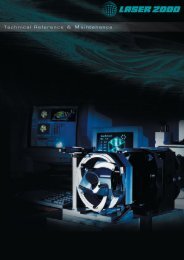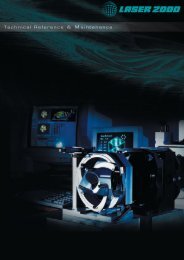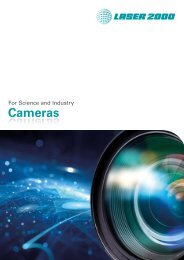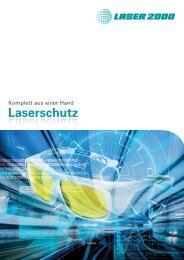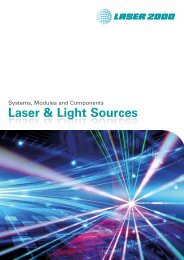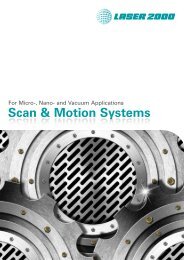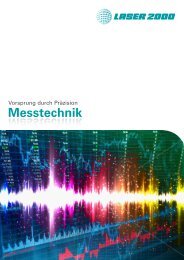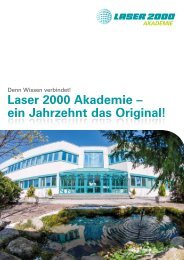Semrock Master Catalog 2018
Semrock Master Catalog 2018
Semrock Master Catalog 2018
Create successful ePaper yourself
Turn your PDF publications into a flip-book with our unique Google optimized e-Paper software.
Fluorophores<br />
Single-band<br />
Sets<br />
Multiband<br />
Sets<br />
Cubes Laser<br />
Sets<br />
VersaChrome ® Tunable Filters<br />
TECHNICAL NOTE<br />
Tunable Bandpass Filters<br />
Thin-film filters are the ideal solution for wavelength selection in most optical systems due to exceptionally high transmission<br />
at passband wavelengths (close to 100%), very steep spectral edges, and blocking of optical density 6 or higher over wide<br />
spectral regions for maximum noise suppression. However, thin-film filters are considered to be “fixed” filters only, such<br />
that changing the spectral characteristics requires swapping filters, thus constraining system size, speed, and flexibility for<br />
systems that require dynamic filtering. Diffraction gratings are often used when wavelength tuning is required, but gratings<br />
exhibit inadequate spectral discrimination, have limited transmission, are polarization dependent, and are not capable of<br />
transmitting a beam carrying a two-dimensional image since one spatial dimension carries spectral information.<br />
Fluorescence microscopy and other fluorescence imaging and quantitation applications, hyperspectral imaging, highthroughput<br />
spectroscopy, and fiber-optic telecommunications systems can all benefit from tunable optical filters with the<br />
spectral and two-dimensional imaging performance characteristics of thin-film filters and the center wavelength tuning<br />
flexibility of a diffraction grating. T There exist several technologies that combine some of these characteristics, including<br />
liquid-crystal tunable filters, acousto-optic tunable filters, and linear-variable filters, but none are ideal and all have significant<br />
additional limitations.<br />
<strong>Semrock</strong> has developed a revolutionary patented optical filter technology: thin-film optical filters that are tunable over a<br />
very wide range of wavelengths by adjusting the angle of<br />
λ<br />
incidence with essentially no change in spectral performance.<br />
As the diagrams (below) indicate, both edge filters and bandpass filters with wide tunability are possible.<br />
T<br />
60° 0° 60° 0°<br />
λ<br />
T<br />
λ<br />
NLO<br />
Filters<br />
Individual<br />
Filters<br />
Dichroic<br />
Beamsplitters<br />
Tunable<br />
Filters<br />
It is well-known that the spectrum of any thin-film filter shifts toward shorter wavelengths when T the angle of incidence<br />
of light upon the filter is increased from 0° (normal incidence) to larger angles. In general, however, the filter spectrum<br />
becomes highly distorted at larger angles, and the shift can be significantly different for s- and p-polarized light, also leading<br />
to a strong polarization dependence at higher angles. The graph on the left shows the spectrum of a typical fluorescence<br />
filter at six different angles of incidence ranging from 0° to 60°. Note that for angles greater than about 30° transmission for<br />
s-polarized light is approximately 0% and the ripple for p-polarized light is intolerably high.<br />
λ<br />
Typical<br />
VersaChrome<br />
In contrast, the spectrum of a<br />
60° 50° 40° 30° 20° 0°<br />
<strong>Semrock</strong> VersaChrome bandpass<br />
100<br />
60° 50° 40° 30° 20° 0°<br />
100<br />
filter (right) maintains high<br />
90<br />
90<br />
transmission, steep edges, and<br />
80<br />
80<br />
excellent out-of-band blocking over<br />
70<br />
70<br />
the full range of angles from 0 to<br />
60<br />
60<br />
60°. At the heart of this invention<br />
50<br />
50<br />
is <strong>Semrock</strong>’s discovery of a way<br />
40<br />
40<br />
to make very steep edge filters<br />
30<br />
30<br />
(both long-wave-pass, or “cut-on,”<br />
20<br />
20<br />
and short-wave-pass, or “cut-off,”<br />
10<br />
10<br />
type filters) at very high angles<br />
0<br />
450 470 490 510 530 550 570 590 0<br />
of incidence with essentially no<br />
450 470 490 510 530 550 570 590<br />
Wavelength (nm)<br />
polarization splitting and nearly<br />
Wavelength (nm)<br />
equal edge steepnesses for both<br />
polarizations of light. An equally<br />
significant and related property is that the high edge steepness values for both polarizations and the lack of polarization<br />
splitting apply at all angles of incidence from normal incidence (0°) to very high angles. As a consequence, it is possible<br />
to angle tune the edge filter, or a combination of edge filters, over this full range of angles with little to no change in the<br />
properties of the edges regardless of the state of polarization of the light passing through the filter. And thus it is now<br />
possible to make tunable thin-film filters which operate over a very wide range of wavelengths – <strong>Semrock</strong>’s VersaChrome<br />
series of filters are specified with a tuning range of at least 11% of the filter edge or center wavelength at normal incidence.<br />
Transmission (%)<br />
Transmission (%)<br />
More<br />
78




